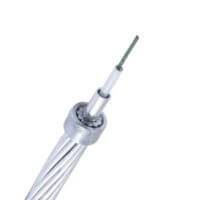OPGW Cable: Integrating Fiber Optics with Overhead Ground Wire

OPGW, or Optical Fiber Composite Overhead Ground Wire, represents a significant advancement in power transmission technology. By combining optical fiber and ground wire functionalities within a single cable structure, OPGW cables offer a cost-effective and efficient solution for both lightning protection and high-speed communication.
Overview
OPGW fiber cable is specifically designed for application in power transmission lines. Its unique cable structure allows it to perform as an overhead ground wire while simultaneously providing a platform for a fiber communication network, eliminating the need for separate cable installations.
Applications
OPGW cables are primarily used in:
- Transmission Power Lines
Features
- Enhanced Protection: The aluminum clad steel wire or aluminum alloy wire shielding protects the optical fiber and acts as an effective overhead ground wire.
- Cost Savings: Eliminates the need for separate cable installations, reducing overall project costs.
- Optimized Placement: The fiber unit’s placement within the cable eliminates concerns about optimal hanging position and electromagnetic corrosion.
- Versatility: Suitable for both newly erected power lines and the replacement of existing ground lines.
- Dual Functionality: Provides both lightning protection and high-speed communication capabilities.
Optical Characteristics
The following table details the optical characteristics of OPGW cables:
| Optical Characteristics | G.652 | G.655 | 50/125μm | 62.5/125μm | |
|---|---|---|---|---|---|
| Attenuation (+20℃) | @850nm | ≤3.0 dB/km | ≤3.3 dB/km | ||
| @1300nm | ≤1.0 dB/km | ≤1.0 dB/km | |||
| @1310nm | ≤0.36 dB/km | ≤0.40 dB/km | @1310nm | ||
| @1550nm | ≤0.22 dB/km | ≤0.23dB/km | |||
| Bandwidth | @850nm | ≥500 MHz·km | ≥200 MHz·km | ||
| @1300nm | ≥500 MHz·km | ≥500 MHz·km | |||
| Numerical Aperture | 0.200±0.015NA | 0.275±0.015NA | |||
| Cable Cut-off Wavelength λcc | ≤1260nm | ≤1450nm | |||
Technical Parameters
The following table presents the technical parameters for different OPGW cable configurations:
| OPGW Fiber | Strand Unit | Nominal Diameter (mm) | Material | Total Breaking Force (kN) | Elastic Modulus (Gpa) |
|---|---|---|---|---|---|
| OPGW 24 | 5 | 12.6 | 20AS | 17.75 | 162.00 |
| OPGW 30 | 5 | 14.55 | 20AS | 17.99 | 162.00 |
| OPGW 36 | 5 | 15.6 | 20AS | 17.95 | 162.00 |
| OPGW 48 | 5 | 17.1 | 20AS | 17.53 | 162.00 |
Conclusion
OPGW cables represent a crucial component in modern power transmission infrastructure. Their ability to simultaneously provide lightning protection and high-speed communication capabilities makes them an invaluable asset for utility companies worldwide. By integrating these essential functions, OPGW cables contribute to a more reliable and efficient power grid while supporting the growing demand for high-bandwidth data transmission.

